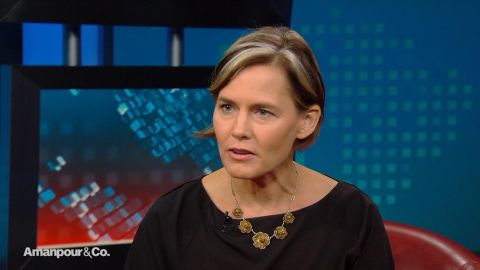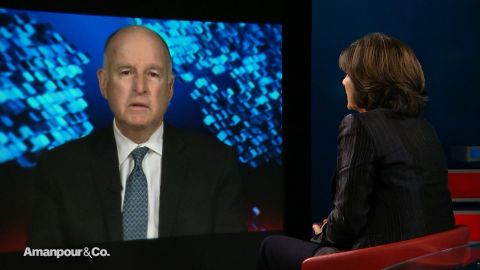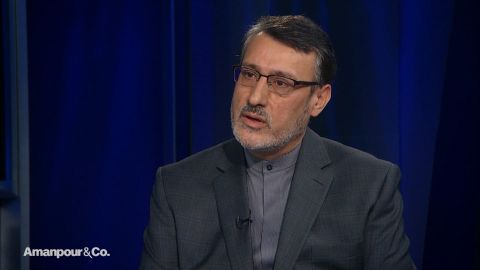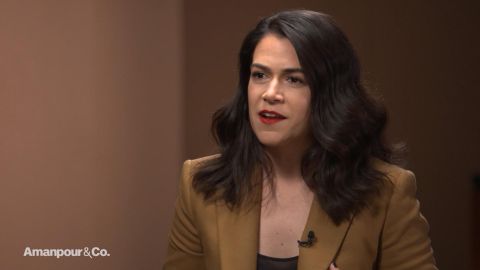Read Transcript EXPAND
WALTER ISAACSON, CONTRIBUTOR: Hey, Jennifer. Thanks for joining us.
JENNIFER PAHLKA, FOUNDER & EXECUTIVE DIRECTOR, CODE FOR AMERICA: Hi, Walter. Thanks for having me.
ISAACSON: You started in the gaming industry. What did you learn from that?
PAHLKA: I was in the business to business media industry doing video game development conferences and trade shows. And it was an amazing time. This was a world in which people were literally creating new worlds that people could play in. And I think it was really the ambition of that community that got me lit up. They were —
ISAACSON: And it made it into a community and almost lead to the Web 2.0, right?
PAHLKA: Yes, absolutely. So I was doing this big show, the Game Developers Conference and sort of watching not only an industry grow but sort of our awareness of what you can do online and what kinds of experiences you can create. And then we transitioned into running something called Web 2.0 which was really about the participatory web. And that was also just amazing because people not just creating sort of imaginary worlds but really changing the world that we live in through technology.
ISAACSON: You know the narrative almost leads up to Code for America. This is a very participatory thing where people are creating services in new ways for government to do services.
PAHLKA: There’s a definite through-line but it’s also true that there’s a huge contrast. So going from a world in which we were working with Twitter and Facebook and Google and their very early days and sort of telling the story of the participatory web, then looking at how you would bring those principles and values to government. Well, government works slowly and uses technology in a very, very different way and that was really what got me started —
ISAACSON: Is that necessary that government has to be slower and use technology different? Or do you think you could really push the government to be more like a startup?
PAHLKA: Well, we’ve pushed the government to be different every day. I don’t necessarily think it should work exactly like a startup. What I do think it can do is bring those approaches that you see in the tech platforms and we think of those as being user-centered, iterative, and data-driven to the government. And I know we can do that because we do it all the time. It’s just that we’ve made government very risk-averse. And when I say we, I literally mean we the people. We can’t just blame politicians and —
ISAACSON: By risk averse, you mean that if the government makes a little mistake and something —
PAHLKA: Yes.
ISAACSON: — we’ll jump on them. Whereas private industry, they can move fast, break things, and then fix them, right?
PAHLKA: Yes. And governments really learn to the — to do these very long planning processes, where they try to get everything right from the beginning, and then they roll stuff out. And it often doesn’t work because it hasn’t actually been tested with users. If you look at how the platforms that we use in our personal lives today were built, they started small and iterative and they tried things, little things, that didn’t work. So we talk about the start of the world of embracing failure but what we’re really saying is fail small and fail fast because the consequences are small instead of doing these big, big, big projects. And then when they don’t work, the failure is really devastating.
ISAACSON: So let’s give some examples here. I mean if I needed a car, I’d hit my Uber app or my Lyft app on my phone here. What have you done for local governments like that?
PAHLKA: Right. So an example of what you would [13:45:00] call an app is something we did in California called Get Cow Fresh. So you know, whether you would apply online for food stamps was an application that took about an hour to fill out. It had about 50 screens, 200 questions, didn’t work on a mobile phone. If you tried to use it on a library computer, the computer would time out before you could get through it. And so we’ve made an application that’s just about seven minutes to fill out, works on your phone. It’s really clear. The language is really simple. But it’s really just an entry point for gaining sort of situational awareness about what users are doing. We know when they’re stuck. We follow up with them by text message. And so we think of it as an app but what it really is is an entryway into changing the policies and operations of the programs based on what the users of the program really need.
ISAACSON: You know you say you follow them by text message too.
PAHLKA: Yes.
ISAACSON: Isn’t that something that would be a radically more simple way to do government if I need my license to just be able to text somebody? Is that possible?
PAHLKA: Well, we’re doing it and lots of others are doing it. It requires a sort of whole scale change in, not just the technology that the government runs, but how the government thinks. We should really be going to where the users are and text message is really where our users are these days. So we have a bunch of programs that we run where we primarily communicate with the users to the government programs by text, including one that helps people stay compliant with the terms of their probation for instance. Much easier to text somebody if you’re about to miss your drug test and you’re on probation. You can text your probation officer and tell them, “Oh, I missed the bus. I’m going to miss my drug test.” And they can help you make sure that you can reschedule it instead of unfortunately going back to jail.
ISAACSON: You know this morning, just by happenstance, I was following my Twitter feed and LaToya Cantrell, the Mayor of New Orleans, which is where I live, tweeted out something that Code for America had done which was called, what is it, Blight?
PAHLKA: Blight Status.
ISAACSON: Blight Status.
PAHLKA: Yes.
ISAACSON: And I looked it up and I actually just went to my phone. Here, I’m actually going to do it here and boom, here it is.
PAHLKA: Yes.
ISAACSON: And it was after the hurricane, the blight. And I typed in — like I can type in Napoleon Avenue and there, boom, done, are all the things in my neighborhood, all the blight, and then tells us what the status is, latest activity —
PAHLKA: Yes.
ISAACSON: — et cetera.
PAHLKA: It was a great project. We did that back in 2012 with an amazing team and it really changed the conversation between the people in the neighborhoods who were advocating for various properties to be demolished or rehabilitated and the government. Because prior to Blight Status, there was no common way of knowing where these properties stood. And so you had these meetings between government and the neighborhood activists that were just sort of shouting at each other. Once they could literally all be on the same page, they started working productively together.
ISAACSON: And Clear My Record. That one fascinated me. Explain that.
PAHLKA: Well, Clear My Record is driven by what we call the implementation gap. So an example of an implication gap is that in every state, virtually California where we live, there are remedies that allow people who have old, low-level convictions on their record to clear them. Very often, these are felonies but they were for maybe dealing marijuana several years ago. If you have that on your record, it means you can’t get a job, you can’t get student loans, you can’t live in public housing. There are thousands of statutory limitations to your life that and it means that you’re probably stuck in a cycle of poverty and incarceration. So the people said, “This is done, why are we doing this? Let’s take this off their records.” And so something like Prop 47 in California that voters passed allows for it legally. But what it doesn’t do is implement the law. And so several years later, only about three percent of people who are eligible to do that have because you have to go to a legal clinic between 9 and 11 on Tuesdays. You have to go get your rap sheet which is by the way written in code and you’re supposed to figure out what it says and verify that it’s correct but you have no idea what it says. There are about 10 steps to the process involving lawyers and courts and fees and filing that really it’s very difficult to get through. Unless you’re incredibly persistent, it takes about a year. What we’ve done at Code for America is show that you can download rap sheets in bulk, algorithmically read them to determine eligibility, and automatically fill out the petitions for the courts. So in theory, we can do this at great scale and just actually honor the intentions of the voters in a short amount of time by not making people petition. And this is how government should run. If we say we’re going to do something, we should do it.
ISAACSON: Now, you can do that one in great scale.
PAHLKA: Yes.
ISAACSON: But it would seem to me that if things require mobile and some, you know, some tech savvy, then we might be exacerbating the digital divide a bit when everything that government does is now becoming service as an app you have to do online and on the phone. What do you do to prevent that?
PAHLKA: Well, certainly mobile is for most people actually greater access than the desktop —
ISAACSON: Computer in a lab, yes.
PAHLKA: Yes. So many government programs sort of moved into the digital age when there was an assumption that you would do this at a computer. For many low-income people, that can be at a library but as I said, that’s not terribly accessible. So mobile is actually a great way to bridge that divide to a certain extent.
ISAACSON: You know something else you’ve been involved in is the U.S. digital service which is slightly different. That’s trying to get techies to sort of the government as part of — you are too, right, as digital service members?
PAHLKA: Yes. So many of them actually are there longer than a year or two now. And same with Code for America, we now take people for long-term gigs and we put them on particular services. USDS is really just building digital competence right at the center of government. So it’s a part of the White House and people come in and they’re bringing all of those skills and approaches. Some of them from government but many of them from the private sector. Many of them from tech companies.
ISAACSON: Is it hard to get people from the private sector that want to go work in government or is it sort of a patriotic thing like serving your nation?
PAHLKA: It is very patriotic. It is something that I think is increasingly seen by the tech community as the most valuable way that they can give back. Because if you work in government to fix problems, you’re working at the greatest scale that you can possibly work at. For example, we think about alleviating poverty in this country. Most of us will think about philanthropy, helping people. Well, philanthropy spends about 42 billion a year on social services, the government spends between 10 and 20 times that. So if you can make a government program just 5 or 10 percent more effective, you can actually eclipse the impact of all philanthropy.
ISAACSON: Another thing that you’ve joined is something called the Defense Innovation Board.
PAHLKA: Yes.
ISAACSON: Which may seem in some ways like a contradiction in terms that, you know, the Defense Department could be that innovative. It started in the Obama administration with Secretary Ash Carter but then General Mattis, the Secretary of Defense now in the Trump administration has asked you and the rest of us to continue. Explain your grandparents who are very part of the military if I remember reading that right. Your parents are a little bit more of that generation that sort of antiwar generation of the late 60’s. Did you have hesitancy about saying I’m going to go help the Pentagon?
PAHLKA: When I was asked to join, my initial answer was no. I didn’t seem like it was my sort of thing. And the more and more I thought about it, I realized that it was pretty important for us to bring these approaches that we’re bringing to all levels of government. Particularly, to the Defense Department where people’s lives are also on the line, Americans’ lives, others’ lives. And you realize how devastating it can be when we get the technology wrong, we get the systems wrong. It really — I realize there’s a lot at stake there. And I decided it was important that if I had anything to bring to the table, I should be bringing it to that table as well.
ISAACSON: And did you find the Defense Department to be receptive or are they resistant to technological change when it comes to the type of system change you’re talking about?
PAHLKA: There is certainly a desire for better technology in the Defense Department broadly. I think what there is is a skepticism that the bureaucratic processes that have grown up around the Defense Department. And frankly, all around government will allow for it. We have these very long complex processes of procurement that involve years of writing requirements, documents, and then years of —
ISAACSON: For weapon systems.
PAHLKA: For anything, for software, for weapons, for the most basic things. I mean one of the things that part of the USDS at the Defense Department, the Defense Digital Services is doing is just the travel system. Everything is harder when you don’t have the right tools because you can’t get software that works. So, you know, do they want it? Absolutely, they want change. But they don’t just want technological change, they want what we call pure bureaucracy hacking. They want to streamline the bureaucracy so that they can do software and systems the way that they’re done well today, the way that makes systems work for people.
ISAACSON: You know so what I’m hearing you say from Code for America, the U.S. Digital Services, the Defense Innovation Board is not just about apps. It’s about applying a new way of thinking and new systems of thinking so that we take what we’ve learned in the technology world and apply it to the rest of our more bureaucratic lives.
PAHLKA: Absolutely. And I think when we say we there, again it’s really everybody has to have that expectation of government. So government’s got to change. The vendors and the ecosystem have to change. And we have to expect government to work that way. And we call it Delivery Driven Government because it’s really about that delivery level where you actually interact with the government services. If those interactions drive the creation of policy and operations, it’s a fundamentally different game.
ISAACSON: Jennifer, thanks for joining us.
PAHLKA: Thank you so much.
About This Episode EXPAND
Christiane Amanpour speaks with Governor of California Jerry Brown, Iranian Ambassador to the UK Hamid Baeidinejad, and actress and writer Abbi Jacobson. Walter Isaacson speaks with founder and Executive Director of Code for America Jennifer Pahlka.
LEARN MORE



